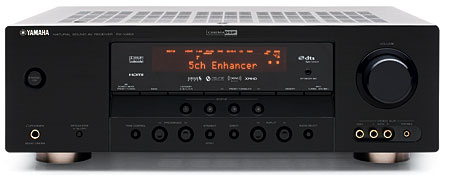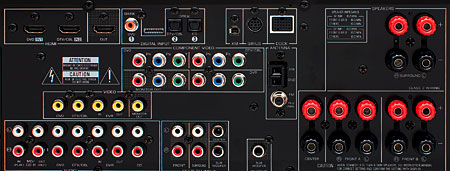Yamaha RX-V463 A/V Receiver
 Price: $350 Highlights: Five channels times 105 watts • HDMI with high-resolution PCM • Includes Yamaha’s YPAO auto setup
Price: $350 Highlights: Five channels times 105 watts • HDMI with high-resolution PCM • Includes Yamaha’s YPAO auto setup
Home Theater Out of the Box
Why would anyone buy a budget receiver and satellite/subwoofer speakers instead of a simpler home theater in a box system? To the uninitiated, the HTIB seems like a no-brainer. It spares the consumer the rigors of equipment matching and sometimes even throws in a disc drive.

I’ll admit that exceptional HTIBs are worth a look, especially now that there are a few models equipped with Blu-ray players. But for the home theater neophyte on a budget, it’s smarter to choose your own speakers, mate them with a budget A/V receiver like the Yamaha RX-V463, and purchase a sepa- rate Blu-ray player. The best sat/sub packages easily outperform most HTIB speakers and offer the same small-footprint ergonomics. With a budget receiver, you can also run larger speakers, as long as they have a sensitivity rating in the high 80s or better. That’s what I did in this review.
Why settle for a flea-amped and under-featured HTIB when your starter system could be something considerably better?
Five Channels of Joy
The RX-V463 is a five-channel receiver rated at 105 watts per channel. Step-up models offer seven channels, but the omission of the back-surround channels needn’t be a deal breaker unless you just can’t get by on two side surrounds. Because it leaves out the back surrounds, the RX-V463 offers Dolby Digital 5.1 but not EX, DTS 5.1 but not ES, and Dolby Pro Logic II but not IIx. This receiver also does
not have onboard decoding for Dolby TrueHD, Dolby Digital Plus, or DTS-HD Master Audio. But it does accept high-resolution multichannel PCM via HDMI, so a Blu-ray player that can decode the next-gen lossless codecs to PCM is a go, at least in 5.1 channel modes.
HDMI connectivity is limited to two inputs and one output (version 1.3). But the receiver also has three component video inputs and one output, so it will accept a total of five HD sources. And it can feed a total of two screens. Not too shabby, eh? There’s no S-video in/out but plenty of composite video for legacy sources. With optional antennas and adapters, the Yamaha can accept Sirius, XM, iPod, and (a rarity) Bluetooth sources.

Other notable omissions include custom installation features such as RS-232, 12-volt trigger, and IR remote jacks. There are no preamp outs except for the sub out, so forget about using this receiver as a processor further down the upgrade path. These nips and tucks are forgivable—no one reasonably expects a budget receiver to fit into a high-end way of life.
The receiver’s front panel features Yamaha’s signature amber display and, compared with most receivers, a minimum of buttons. It includes a pair of up/down buttons for source selection, but there’s no knob or dedicated source buttons. However, there are four “scene” buttons that select sources and associate them with settings. You might program one of them for DVD movie viewing and another for CD music listening from the same input. The scene controls are a Yamaha exclusive.
Finally, the RX-V463 includes the Yamaha Parametric Acoustic Optimizer (YPAO) automatic setup and room-correction program. Plug in a supplied setup microphone, and the receiver handles speaker settings and other parameters. It’s appropriate that this $350 receiver offers this newbie-comforting feature. It’s also a sign of how far budget receivers have come in the past few years.
I reviewed the Yamaha with five Paradigm Reference Studio 20 monitor speakers. I ran them full range, which is a slightly greater challenge than delegating bass response to a subwoofer. I did this to add a little stress to the review process. Most systems would use a sub, relieving the receiver’s amplifier section of bass-response duties.
My signal source for this review was a first-generation Pioneer BDP-HD1 Blu-ray player. This player decodes Dolby TrueHD and sends it through the HDMI output as high-resolution PCM, so the player and receiver together could decode TrueHD and play it at full resolution. The Pioneer also decodes the lossy, 1.5-megabit-per-second core stream of a DTS-HD Master Audio signal and sends it through the HDMI out, but only as old-school DTS 5.1. This wastes much of DTS-HD Master Audio’s resolution.
 Living in a Lossless World (Sort Of)
Living in a Lossless World (Sort Of)
The Eye (Blu-ray), in DTS-HD Master Audio, has significant midbass content in the form of menacing synth tones. They were just the right weight—I didn’t miss my sub. Loud midrange-centered synthesizer attacks mixed with vocal sounds filled the soundfield effectively. The central character, a woman who sees the future through her transplanted corneas, is a concert violinist. The receiver did well with the film’s brief snatches of solo violin and orchestra.
Witless Protection (Blu-ray), also in DTS-HD Master Audio, might be fun in a theater full of Larry the Cable Guy fans. I got to hear the rustic Falstaff snore in surround, a sound that might frighten pets. The destruction of the Larrymobile presented some brief explosive sound effects. Musical moments, including “Achy Breaky Heart,” felt more lossy than lossless, for which I don’t blame the receiver. I just need to get my hands on a player that does DTS-HD Master Audio right.
The Yamaha’s best chance to shine was Broken Trail (Blu-ray) in Dolby TrueHD. This cowboy miniseries plunges Robert Duvall and Thomas Haden Church into a rich, eventful sonic world as they shepherd a group of teenage Chinese girls through a hostile and exploitative wild-west landscape. The roar of a steam train, the crackling of a nighttime fire, the mooing of cattle, the thunder of horses’ hooves, and other effects were spell-binding in high-resolution surround. The Yamaha delivered them with impressive lossless realism. I frequently forgot I was on the sofa watching a movie. Equally impressive was the music, which blended Chinese and western instruments and styles, including a prominent, soulful solo cello. If I’d played this movie for an untutored friend and asked, “What do you think of my new $1,000 receiver?” they probably would have responded, “Sounds great! Where can I buy one?”
And Through the Wire
At other times, as on Peter Gabriel’s self-titled third LP, a more costly receiver would have gotten greater bass weight out of the Paradigms’ 7-inch aluminum-coned woofers. An example is Phil Collins’ stomping drum part on “The Intruder.” But the Yamaha clearly loved analog. It completely lost the top-end edginess it occasionally exhibited with lossy digital sources. When I activated the Direct mode and listened in two channels, things got even more interesting. The soundstage warmed up further, and directional cues intensified and seemed to float near the speakers’ outer boundaries.
Piano Starts Here: Live at the Shrine is a re-creation of two Art Tatum concerts. Zenph Studios used the original mono analog tapes from 1933 and 1949 to create a MIDI file. A Yamaha Disklavier played the file, and Zenph made a fresh recording for this multichannel SACD. The result combined the original rhythm, touch, and other nuances of Tatum’s performance with pristine 5.1-channel sound. The receiver did a great job of conjuring the uniquely limpid, unclattery, and underrated sound of a Yamaha concert grand, which is always recognizable whether the player is a human or a ghost.
A rich, vibrant string sound is something I expect any good receiver to deliver. The Haydn: Complete Symphonies 33-CD boxed set (Brilliant Classics) was almost too easy a test. The 104 symphonies that Adam Fischer and the Austro-Hungarian Haydn Orchestra recorded over a 14-year period always sound mellow and sweet. The dominant acoustic element in this massive labor of love was the historic Haydnsaal at the Esterházy Palace—where many of the symphonies premiered—as opposed to the bowing or inner detail of the strings and other instruments. This was especially apparent in the solo cello passage of the 13th symphony’s opening “Allegro molto,” which emerged with more hall than cello. The solo flute passage of the same work neatly defined the hall’s boundaries. At no point did the presentation sound vague or uninvolving. It was just the kind of reverb-enriched sound you’d hear in a first-class concert hall seated about three-quarters of the way back from the stage.
Considering the burden it had to bear—powering five full-range speakers without a sub—the Yamaha RX-V463 acquitted itself well. It proved itself capable of surprises with the right source material. And there wasn’t any material it couldn’t handle competently. The mix of features is pragmatic and generous considering the $350 price tag. If you mate it with a good set of reasonably efficient speakers and a sub, this receiver will certainly get your starter system off the ground. On a good day, it might even loft it into the stratosphere.
- Log in or register to post comments






























































